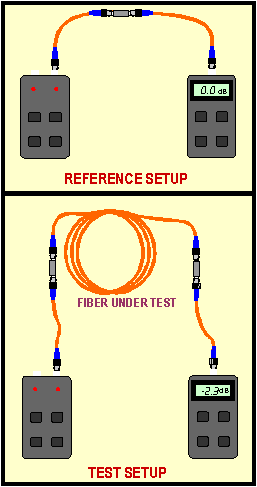In the last issue of “Fiber Optics Newsletter” we emphasized the importance of proper loss testing to ensure the quality of the fiber optics installation. So, how should the test equipment be connected to the system?
The primary consideration when testing a fiber system is to know exactly what you are testing so that the calculated loss can be compared to the measured loss. One key point is that in order to measure the loss of a fiber optic connector it must be mated to another fiber optic connector. That may seem like an obvious statement, however, the light sources and power meters used for fiber optic testing most often have the light source and the light detector located in the connector adapters themselves. That is, if you connect the light source and a power meter directly to the link to be measured without using a patch cord, you are not making a fiber connector to fiber connector junction. In order to accurately assess the quality of the connections in your system, a patch cord must be used at both the source and the power meter ends of the test set up. Thus the best way to do the fiber loss test is to connect a patch cord to the power meter and connect a second patch cord to the light source. Using a connector sleeve, connect the two patch cords together to give the reference reading. Zero the power meter at that level. Then disconnect the patch cords from each other without disturbing the connections at the ends. Finally connect one patch cord to one end of the system under test and the other patch cord to the other end. The diagram below illustrates this.

(Or give us a call and we can fax or email you a more detailed diagram)
If you take a look at the differences between these two setups you can see that the loss difference will be the total loss of the system under test plus one connection loss. That is, if there are no other connectors in the system, then the differences in loss between the reference and the measurement will be the loss of the fiber plus one extra connection loss. If you calculate the loss of your fiber system ahead of time and specify this loss measurement technique then the accuracy of your fiber loss measurements will be limited only by the repeatability of the fiber connections, and should be good within plus or minus 0.2 dB.
The money saving tip for fiber system owners: specifying proper fiber test techniques during your initial installation will ensure that you get an accurate measurement of the quality of the fiber installation and will be a useful tool for future diagnosis if problems arise. Revenue generating tips for installers: proper documentation of your test results including an explanation of the setup used will ensure top quality test results. Both you and your customer will be confident the installation has been done properly. Your installers will save time because they will not wonder about proper test procedures. And your customers will be impressed with your knowledge and professionalism.
Next up: “Where does OTDR testing fit”?

